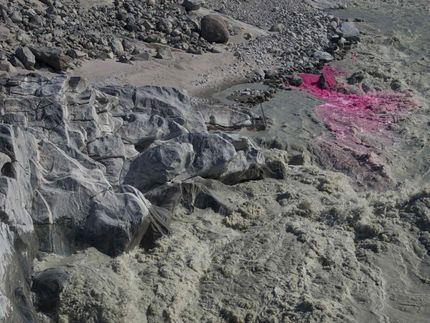Soil crusts emit nitrogen oxides and nitrous acid
Study shows that biological soil crusts release large quantities of reactive nitrogen compounds
For a long time now, researchers have been racking their brains over the large quantities of reactive nitrogen compounds observed in arid regions after periods of rainfall without being able to identify the source. A study is now bringing light into the darkness. Bettina Weber and her colleagues from the Max Planck Institute for Chemistry in Mainz, the Max Planck Institute for Biogeochemistry in Jena and the Biodiversity and Climate Research Center in Frankfurt (BiK-F), were able to prove that biological soil crusts in arid regions emit nitrogen monoxide (NO) and nitrous acid (HONO) when moistened. The two reactive nitrogen compounds play a key role in the production of ozone and OH radicals, which control the atmosphere’s oxidation and self-cleaning properties.
For several years, cryptogam layers composed of soil crusts, among other things, have been causing a stir in earth system and climate research. Indeed, in 2012, a team of researchers led by the Max Planck Institute for Chemistry were able to show that soil crusts are responsible for around half of the biological nitrogen fixation to the Earth’s surface. Bettina Weber and her colleagues took up the question of what happens to the large quantities of fixed nitrogen in the subsequent materials cycle. They have now managed to find their first answer and uncover a hitherto unknown release process for reactive nitrogen compounds.
“Our investigations have shown that biological soil crusts in arid regions release NO and HONO, whereby the quantity corresponds to around 20% of the amount of nitrogen oxides released globally through soils,” explains Bettina Weber, Group Leader in the Multiphase Chemistry Department at the Max Planck Institute for Chemistry, before adding: “While the release of nitrogen monoxide has already been demonstrated in other studies, we have now been able to prove that nitrous acid is also formed and released by biological soil crusts.”
It had previously been assumed that the release of nitrogen monoxide was due to abiotic processes. However, Bettina Weber’s team has now clearly proven that the organisms present in the soil crusts are responsible for the release.

Biological soil crust dominated by lichens and cyanobacteria in the Succulent Karoo, South Africa.
Bettina Weber
Small-scale power plants in barren regions
“Biological soil crusts are like small-scale power plants,” explains Bettina Weber enthusiastically. “These layers, which are only a few millimeters thick, conceal a concentrate of organisms consisting of producers, consumers and decomposers and thus represent one of the smallest ecosystems in the world. This is where many processes important for the earth system happen in the smallest of spaces.” As the study shows, biological soil crusts in arid regions clearly play a key role in releasing atmospherically reactive nitrogen compounds. “Precipitation plays a major role, since moisture triggers the metabolic process in biological soil crusts,” adds Hang Su, who is also Group Leader in the Multiphase Chemistry Department at the Max Planck Institute for Chemistry and was involved in analyzing the data as a modeler.
Additionally, a team of researchers was recently able to prove, with involvement of the Max Planck Institute for Chemistry, that cryptogam layers also release nitrous oxide and negligible quantities of methane into the atmosphere. “Up until now, cryptogam layers were not included in global climate models. Given the number of new findings concerning how highly influential they are on biogeochemical cycle processes, they can no longer be left out,” summarizes Hang Su.
Biological soil crusts make up around one-ninth of the Earth’s surface. Since it can be assumed that climate change will continue to modify both the occurrence of soil crusts and the distribution and frequency of precipitation, the surface covers should be further examined and the results incorporated into computer models of the global materials cycles.
Original publication
Original publication
B. Weber, D. Wu, A. Tamm, N. Ruckteschler, E. Rodríguez-Caballero, J. Steinkamp, H. Meusel, W. Elbert, T. Behrendt, M. Sörgel, Y. Cheng, P. Crutzen, H. Su, U. Pöschl; "Biological soil crusts accelerate the nitrogen cycle through large NO and HONO emissions in drylands"; PNAS; 2015
Topics
Organizations
Other news from the department science

Get the chemical industry in your inbox
By submitting this form you agree that LUMITOS AG will send you the newsletter(s) selected above by email. Your data will not be passed on to third parties. Your data will be stored and processed in accordance with our data protection regulations. LUMITOS may contact you by email for the purpose of advertising or market and opinion surveys. You can revoke your consent at any time without giving reasons to LUMITOS AG, Ernst-Augustin-Str. 2, 12489 Berlin, Germany or by e-mail at revoke@lumitos.com with effect for the future. In addition, each email contains a link to unsubscribe from the corresponding newsletter.



























































